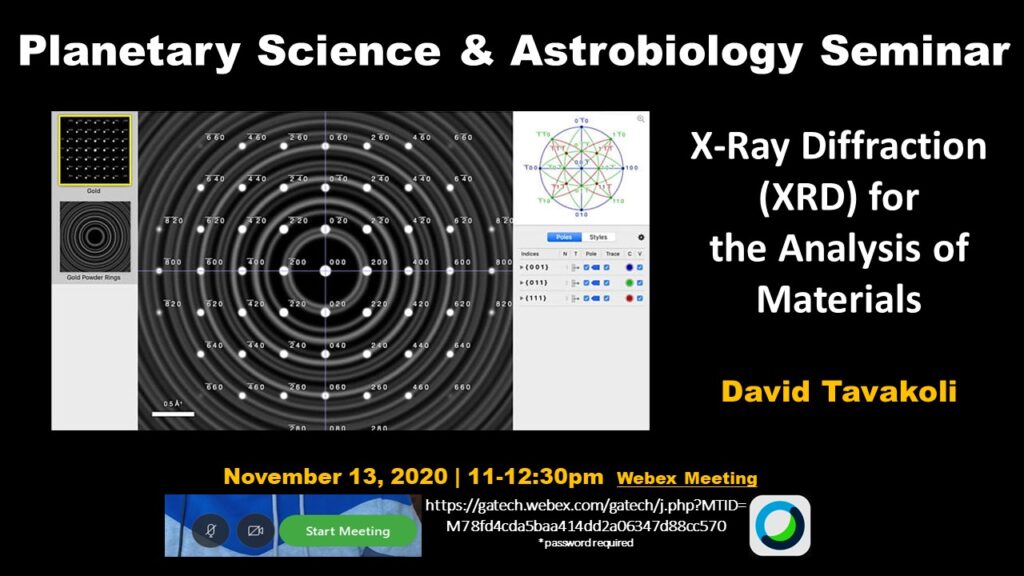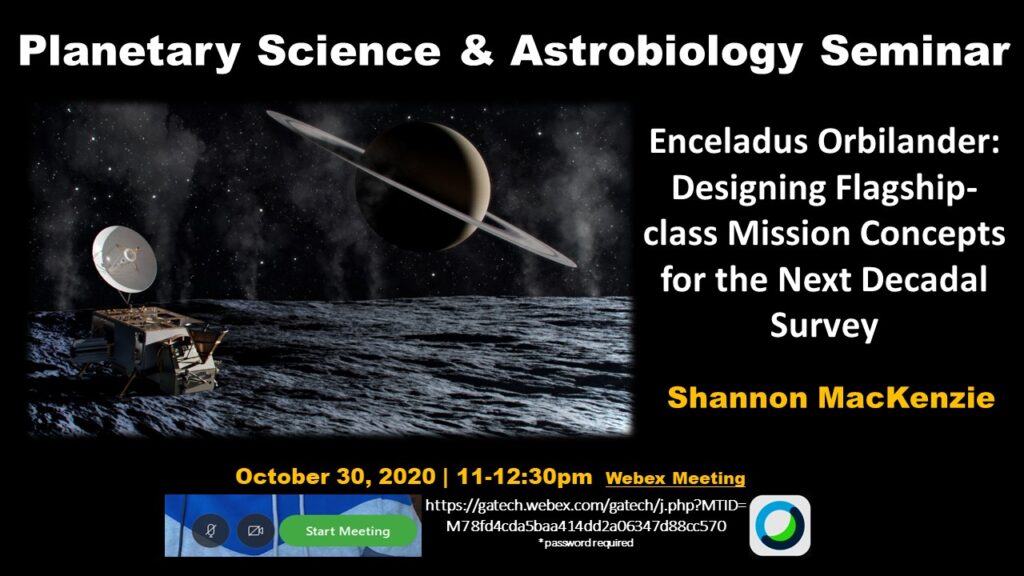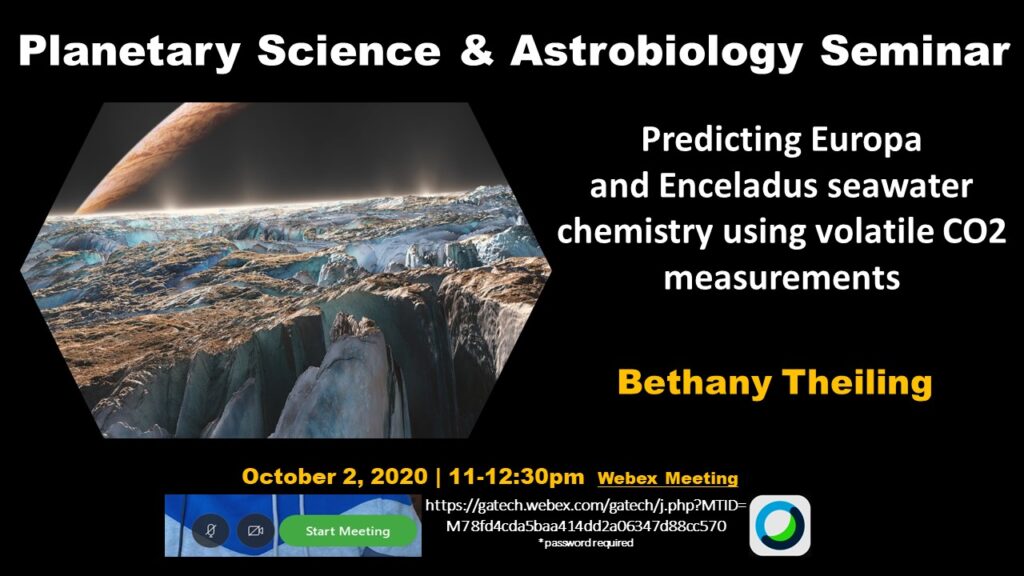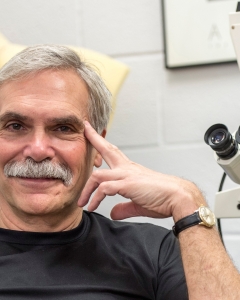PSAS: The Final Harvest of Dawn: Spotlight on Occator Crater
PSAS: X-Ray Diffraction (XRD) for the Analysis of Materials

XRD is a powerful technique to perform qualitative and quantitative analyses of materials and is most widely used for the identification of unknown crystalline materials. Determination of unknown solids is critical to studies in geology, environmental science, and material science to name but a few. When X-Rays contact a crystal, a series of reflections are produced that are unique and characteristic for each phase, similar to a fingerprint. It is a method that does not require large amounts of material, even very small amounts of material can be measured with special holders, and is non-destructive. This presentation will be focused on how XRD is used to measure materials from domestic and extraterrestrial sources.
PSAS: Space Weather: The Science, its Effects and Mitigation

Solar flares can produce x-rays that affect satellite communication in the near-Earth environment, it can degrade or block communication signals. Solar energetic particles can penetrate satellite electronics and cause electrical failure. Coronal Mass Ejections (CME’s) can cause Geomagnetic Storms at Earth and induce extra currents at the ground that can degrade power grids and other infrastructure. All these events are termed space weather and need to be studied, forecasted, and notified in advance to mitigate its effects. In this seminar, we will talk about space weather, its effect, and forecasting capabilities to mitigate its effects.
PSAS: Enceladus Orbilander: Designing Flagship-class Mission Concepts for the Next Decadal Survey

Cassini revealed Saturn’s moon Enceladus as the host of a subsurface ocean where the key factors of habitability appear to be collocated. A return mission is needed to determine if that habitability potential supports life, but how should such a search for life be conducted? What biosignatures might we target? What geochemical and geophysical investigations would provide the context most useful for interpreting biosignature searches? In preparation for the 2023-2032 Decadal Survey, we explored what Flagship-class (>$2B) missions answering these questions might look like. In this talk, I’ll describe how we defined the driving science goals and objectives, selected a representative payload, and evaluated the science value of different architectures. I’ll then present the result of our study, Orbilander, a mission concept where a single spacecraft first orbited and then landed, and why it represents a compelling option for returning to Enceladus to search for life.
Auto Draft
PSAS: How inappropriate to call this Planet Earth
Brief summary: The very first “ocean life detection” mission took place on board the HMS Challenger in 1872, as it set out to establish the existence of life at the deepest ocean depths. Scientists and crew sailed for four years collecting chemical, geological and biological samples from the far reaches of our world, and produced to first comprehensive survey of Earth’s ocean – from sea surface to sea floor. Today, scientists explore the ocean through a combination of human-operated and autonomous instruments. The technological landscape is changing at an unprecedented rate. Space scientists are also rapidly developing technologies required for missions to other worlds, including ocean worlds, despite the striking difference in the resources invested in ocean versus space science instrumentation. Our laboratory focuses on better understanding how matter/enery flow between the biosphere and the lithosphere. To that end, we develop technologies that help further our understand of these relationships, both in the ocean and on land.
We are, however, also committed to democratizing science by developing modular, open-design vehicle and sensor platforms that allow inexpensive commercial sensors (as well more bespoke emerging technologies) to be easily deployed on deep-sea missions. Here I will present some of the latest developments -as well as the lessons- from exploring our own inner space. We will also present our data from recent efforts aimed at examining the relationships among abiotic and biological processes in our ocean. These technologies and methods can help us unlock the mysteries of the cosmos, in particular that enduring question of whether life exists on other celestial bodies. We posit that fostering a rich and extensive collaboration among ocean and space scientists is critical if we are to advance our understanding of other ocean worlds, such as Enceladus and Europa, beyond the scope of current missions and technologies.”
PSAS: Predicting Europa and Enceladus seawater chemistry using volatile CO2 measurements

The Europa Clipper mission will be able to measure volatile CO2 isotopes of Europa’s plumes and exosphere—but what can those measurements tell us about the surface ice or subsurface ocean? Our laboratory experiments interact an initial gaseous CO2 (that may be sourced from water-rock interactions at the seafloor) with various seawaters, and measure the resulting CO2 to determine what changes take place as a result of this interaction. Isotopes of CO2 from low pH systems do not show a substantial change for carbon, suggesting that carbon isotopes from a low pH Europa will reflect the original CO2.
However, alkaline (high pH) systems similar to Enceladus or a high-pH Europa show a large variability in carbon isotopes that is due to varying carbonate speciation. We use our laboratory spectra as a ‘training’ dataset for machine learning. Our preliminary work demonstrates that ‘supervised’ training of metadata and data from these spectra form clusters based on the concentration of CO2 and the composition of the seawater, and is therefore promising for future interpretation of CO2 mass spectra using predictive algorithms.
PSAS: Don’t Lose Hope Even When NASA Cancels Your Mission: The Camera on ExoMars Trace Gas Orbiter

R. F. Rosenzweig – Virtual Seminar – May 22
ExplOrigins & Astrobiology Primer Community Review
Speaker: Frank Rosenzweig
Affiliation: Georgia Institute of Technology, Department of Biological Sciences

Date: Friday, May 22, 2020 – 10:00am
Location: BlueJeans
Host: ExplOrigins Group
Title: Microbial adaptation to chronic nutrient limitation


